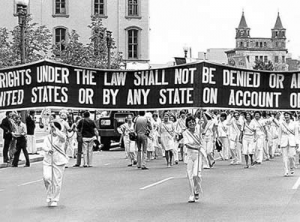Time to Finally Pass the Equal Rights Amendment?
 In 1776, as the founders were meeting to form the new government for the nation that would become the United States of America, Abigail Adams wrote to her husband John Adams and asked him “to remember the ladies” while drafting the governing documents. She continued,
In 1776, as the founders were meeting to form the new government for the nation that would become the United States of America, Abigail Adams wrote to her husband John Adams and asked him “to remember the ladies” while drafting the governing documents. She continued,
[B]e more generous and favorable to them than your ancestors [have been]. Do not put such unlimited power into the hands of husbands. . . . [I]f particular care and attention is not paid to the ladies we are determined to foment a rebellion, and will not hold ourselves bound by any laws in which we have no voice or representation.
Quoted in Susan Gluck Mezey, Elusive Equality: Women’s Rights, Public Policy, and the Law 5 (2011) (internal citations omitted).
John Adams responded, “I cannot but laugh . . . .” Id. To Mr. Adams, this was the first he’d heard of women’s possible discontent with the status quo. “[Y]our letter was the first intimation that another tribe, more numerous and powerful than all the rest were grown discontented.” Id. For whatever “power” that Mr. Adams suggested that women had, it clearly wasn’t enough, for the new Declaration of Independence and Constitution failed to give any express (or even implied) rights to women.
Mrs. Adams responded to her husband, “I cannot say that I think you are very generous to the ladies; for whilst you are proclaiming peace and good-will to men, emancipating all nations, you insist on retaining an absolute power over wives.” Id.
